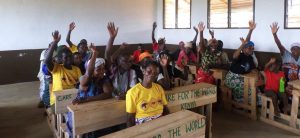
Every farmer wants to be part of the Elephants & Bees project. It is a fantastic, simple and new innovation that not only protects their farms from crop-raiding elephants, but also enables them reap the great benefits. Beekeeping offers an alternative source of income through the sale of the harvested honey, wax and other products. The farmers also get to enjoy the honey as a food source and for its medicinal value. More and more farmers have gained interest in the use of beehive fences especially since is it the sole elephant-human conflict mitigation measure currently being employed. The news of its success has been spreading like wildfire way beyond the foot of tiny hill in which the project was first started.
The idea
Recent visits with farmers in Dr Lucy King’s Elephants and Bees project (EBP) Sagala mountain region have revealed that the project’s presence in the area needs to grow. So it was quite a pleasant surprise when, over a cup of tea, area Assistant Chief Mr. Alex Mwabingu suggested; “Lucy, it is high time you have an office around. A project as great as yours needs to expand. It is important for you to have a base where the farmers can come to you for questions and demonstrations and such! I think the community would be happy to set aside a piece of land if you are interested?” This was really good news for the team, coming from a highly respected community leader, as it reinforced the vision to have a permanent project site where we would hold bee farming and other educational workshops, and reach even more farming communities in the wider region. Dr. King thanked him and joked of how she had been using her car for everything, as an office, a store for beehives, paint, poles, wire and other hardware supplies among many other tasks. It was then decided that the chief would soon call for a community meeting at the nearby school, where the idea would be pitched to the people.

The pitch
On the day of the meeting, the villagers gathered in one of the empty classrooms. There was good representation of the community, from the young to the old, and a seemingly equal ratio of men to women. They all appeared to be quite interested in what was to be discussed. After brief introductions, the agenda of the day was brought forth. The chief first spoke of the benefits that the Elephants and Bees project (EBP) had brought to the area, and how more farmers need to involved. He then proposed that the people should donate a piece of community land to build a Human-Elephant Conflict Centre that would not only serve a conservation research/educational purpose but also have a space large enough to hold future community meetings and events such as weddings. At this point, it seemed that some were sold on to the idea while others still needed convincing. With the aid of a sketch on the chalkboard, Dr. King described the centre; it was to be a simply-built structure using locally available materials, with an open air design to maximize on light and air flow. It would run on solar power and a rainwater collection system. The environmentally friendly centre would be comprised of an office, a small dormitory room where the EBP team and visiting researchers would sleep, and a storage room that would double up as a honey processing and packaging room. At the centre of the building there would be a half-walled open space, where meetings/workshops be conducted. Dr. King also assured the villagers that labour for construction would be locally sourced as a measure to develop the community. The participants were then given some time to openly discuss the idea. Some debate ensued on where the site location after which it was decided that it would be closer to the primary school for security reasons, but far enough so as not to disrupt the school program. We then took a vote for or against the proposed centre and it was clear as crystal that everybody loved the idea. There was excitement in the air; the room was abuzz with the prospect of having such a community centre so close to home. Afterwards, we all walked a short while to the one acre piece of land that was to be allocated to the project. It was pristine bush land, right next to the road for easy access and perfect for our dream project centre. Back at the school, it was celebration time over a feast of never ending cups of sugary tea and tasty loaves of bread. We took many group photos as people left, right and centre congratulated us on bringing this project to life. The village had for long desired to have such a community centre that would educate the masses and in turn, ensure development. Dr. King assured them that the construction would start as soon as possible, in order to have the centre running in the early months of the coming year, 2014.

In gratitude
The Elephants and Bees Project would like to thank Save the Elephants and the Rufford Foundation for their huge donations that have fully funded the construction of the Elephants and Bees-Human-Elephant Conflict Research Centre and the acquisition of necessary honey processing equipment. We have, in appreciation, dubbed the honey processing room ‘The Rufford Honey Room’ The construction of this centre could not have come at a better time. It is the best Christmas present!



